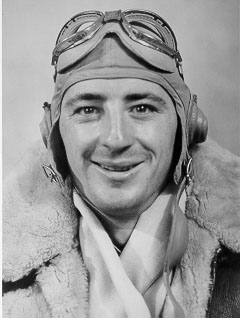GWINN-WILBUR
WILBUR CHARLES "CHUCK" GWINN

LT

HE DISCOVERED USS INDIANAPOLIS SURVIVORS
The heavy cruiser USS INDIANAPOLIS (CA-35) was chosen to deliver a secret cargo from San Francisco to Tinian Island, components of the atomic bomb, Little Boy, the first atomic bomb used in combat which was dropped on Hiroshima, Japan. After the delivery, INDIANAPOLIS was ordered to proceed to the Philippines and on July 30, 1945, when approaching the Philippine Islands, the ship was torpedoed by the Imperial Japanese Navy submarine I-58 and sank in 12-minutes. Of the 1,196 crewmen aboard, approximately 300 went down with the ship. The remaining 900 faced exposure, dehydration, saltwater poisoning and shark attacks while floating with few lifeboats and almost no food or water. The Navy learned of the sinking four days later when survivors were luckily spotted by the crew of a PV-1 Lockheed Ventura patrol plane on routine patrol.
On the morning of August 2, 1945, a land based PV-1, piloted by LTJG Wilbur C. Gwinn, departed from Peleliu in search of enemy submarines. During the flight the crew experienced trouble with an aerial antenna so LTJG Gwinn handed control over to his copilot and moved to the back of the plane to attempt to fix the equipment. When Gwinn experienced soreness in his neck as he hunched over the antenna, he stetched out in a nearby gun blister. Looking down he happened to focus his eyes on the water below at just the right moment. Seeing what he later described as a big black smudge in the water, Gwinn assumed it might be from a Japanese submarine disabled in the ocean below. Excited with his find, LTJG Gwinn took over the controls again and circled around hoping to drop his bombs on the imagined submarine. But, as he drew nearer, he realized there were a large number of men bobbing lifelessly in the water. He immediately radioed his discovery to his base on Peleliu. Gwinn also dropped what life jackets and canisters of water he had to the survivors, but the canisters ruptured on impact.
Rather than immediately sending a rescue crew, the Navy ordered a single airplane to do recon. A PBY-5A Catalina seaplane, piloted by LT Adrian Marks took off from Peleliu. Upon arrival, he found many men in the water but was horrified to see a shark savagely attack and devour a screaming sailor. Although he had orders to only look and report, he told his crew he was landing to assist the struggling sailors. The landing was difficult because of 12-foot swells, but the landing was successful and his crew was soon pulling sailors aboard. When they ran out of room inside the plane, men were wrapped in parachutes and tied to the plane’s wings. They finally brought 56 men aboard the PBY before a rescue ship arrived several hours later. Only 317 men from the INDIANAPOLIS crew were finally rescued.
After the war, Gwinn was employed by the East Side Union High School District in San Jose, California. He was responsible for the maintenance and repair of the district’s office and ten high schools. Chuck Gwinn regularly attended USS INDIANAPOLIS reunions where he was called “Angel of the Sky” and often said, “I could never buy a drink.”
Submitted by CDR Roy A. Mosteller, USNR (Ret)

